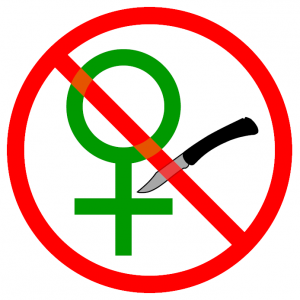female genital mutilation: it’s closer to home than you think
It is a murky practice that is rarely discussed within its own culture, let alone outside it. Khadija Gbla is a nationally recognised spokesperson and survivor of Female Genital Mutilation. ‘I didn’t even know what Female Genital Mutilation was growing up, I never heard of it being spoken of,’ Khadija says.
Khadija, aged 27, was born in Sierra Leone, but fled to Gambia as a refugee, before settling in Australia at 13 years old. Before arriving in Australia, she underwent a forced clitoridectomy. Khadija was nine-years-old at the time. Her mother told her they were going on a holiday but instead took her to the bush, where an elder woman emerged in traditional dress.
‘She took my clothes off and the next thing I knew my mother was pinning me to the floor and holding me down.’ Khadija thought she might die as the woman began to slowly slice off Khadija’s clitoris.
‘A rusty knife on the flesh – that’s hell, it’s not a quick procedure,’ Khadija says.
FGM is typically performed between five and eight years old, but can occur in infancy or during adolescence. While a younger generation of men are now rejecting this practice for their own daughters, Khadija describes the important role that men still play. ‘It’s done to please them, they are the beneficiaries of the practice.’
No FGM Australia estimates that three girls in Australia are at risk every day. Although there’s an assumption this is strictly a foreign practice, there have been numerous cases in Australia.
No FGM Australia Director, Paula Ferrari says that most Australians are unaware of its existence in Australia. ‘It’s very hard to convince people this is happening, but there are girls at risk,’ Ferrari says.
There have been various cases of FGM throughout the country that are currently under investigation. In New South Wales, there are two separate incidents currently being trialled. Both of these separate incidents reportedly occurred in the homes of the girls’ parents. It’s important to note that the young girls involved are still residing with their parents, despite the fact that they are facing potential gaol time.
Ferrari adds that some are not only practicing FGM in Australia but allegedly profiting from it. ‘We have reports of a woman in Brisbane who is charging $1000 per procedure, and this is still being investigated by Queensland police,’ she says.
No FGM Australia states there are common warning signs of a planned clitoridectomy, this includes promises of exotic holidays, the enticement of receiving gifts and girls being told they are about to enter womanhood.
This practice has a history in western culture too. ‘In Victorian times it was quite common. If little girls masturbated too much they would be taken down to the doctor to have a clitoridectomy to control it,’ explains Ferrari.
An article published in the Medical Journal of Australia states that the increase in immigrants from Africa has created a demand for FGM and this may be on the rise.
In Australia, practicing FGM is illegal and punishments range from seven to 21 years in prison. But there are grey areas that enable it to continue. Following childbirth, many women will request to have their vaginas resewn. While this is partly done to repair tears that routinely occur during childbirth, there is social pressure to retain their altered appearance.
Both the Australian Medical Association and The Royal Australian and New Zealand College of Obstetricians and Gynaecologists were unavailable for comment. However, RANZCOG’s official policy on FGM is as follows:
‘RANZCOG condemns the practice of any form of FGM because these practices violate the human rights of girls and women. Doctors, nurses, and others are asked to be aware of women and girls who are at risk of FGM, and these procedures are illegal in Australia and New Zealand.’
Ferrari suggests that simple questions are crucial in figuring out if the procedure actually occurred. She recommends practitioners ask the following types of questions:
- Have you ever been cut / circumcised?
- Where was it done?
- How old were you?
The World Health Organisation (WHO) documents four types of FGM. These range from removing the clitoris to what is called infibulation, in which several parts of the external vagina are removed, before being sealed over with a flap of skin.
‘The government does not collect data on this… how can we address it, if we don’t know the full extent of what we’re dealing with?’ Ferrari asks.
Khadija’s adolescence was marked by insecurities and uncertainty. ‘This “clitrocentric” society was all about the clitoris and what is a woman who doesn’t have a clitoris meant to feel?’ Khadija asks.
Despite a legal obligation for doctors to report suspected child abuse, Khadija’s practitioner did not file a report.
‘It was treated in isolation so I was never treated as a complete person, they treated my FGM as inconsequential.’ Khadija’s experience serves as a perfect example of how badly the system is letting down a generation of young girls.
No FGM Australia routinely receive reports of FGM. ‘I call child protection, child protection says “call the police”. I call the police and they say “call child protection”. Or I call immigration and immigration say “call human services”,’ explains Ferrari.
In September last year, the Victorian DHHS introduced tougher legislation regarding child abuse. Amongst these changes was a new law that every adult is now legally required to report suspected child abuse to the police.
When asked to comment on the issue, the DHHS provided the following response:
‘The issue of female genital mutilation is very concerning and is taken seriously by the Department… Reports concerning female genital mutilation are assessed and where appropriate investigated with action focussed on preventing this abuse and educating those affected. ‘
But since this practice is cloaked in so much secrecy, it is unclear how much impact these changes will have. Aside from the legal ramifications, people within communities that routinely practice FGM face being persecuted and ostracised by their families if they talk to the authorities.
Like many other women, Khadija has struggled with several health conditions, including fibroids, cysts and severe pain during intercourse. She also faced dangerous complications during her recent pregnancy. The WHO website states these are common side-effects of this procedure.
‘It’s another form of child abuse, it just happens to be a minority group that we don’t think we need to meddle in,’ Khadija observes.
Last year, a man flew his nine-month-old daughter to Indonesia to be circumcised. His wife was completely unaware this took place. It was only discovered by a doctor during a routine health check. This is another case currently under investigation. However, only the father has been charged.
For Khadija Gbla, this is a frustrating battle. The practice of FGM is deeply rooted in foreign cultures, with its practice in 29 countries in Africa, South East Asia, notably Indonesia and Malaysia, and some Middle Eastern countries. It also happens wherever people from countries which practice FGM have immigrated including the UK, USA, Europe and Australia. Khadija believes many Australians are afraid of appearing racist: ‘cultural arguments are not an excuse to abuse a child, hit a woman or to kill a girl’.
Khadija, along with No FGM Australia have begun a petition that would develop a taskforce including the ‘Departments of Health, Education, Immigration, Attorney-General, Social Services and Police to develop a strategic plan to address FGM in Australia’.
It would also allow them to collect more detailed data on the prevalence of FGM in Australia and fund programs to support survivors of the practice. The petition needs 10,000 signatures.
Retraction: An earlier version of this article contained factual errors regarding Ms Gbla’s experiences, FGM data collection in Australia and insufficient description of how widespread the practice of FGM is. We regret the error.



Pingback: nobody puts baby in the corner: bodily autonomy and infants | lip magazine